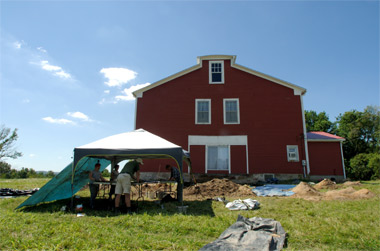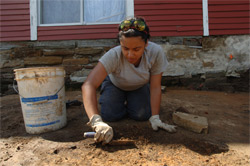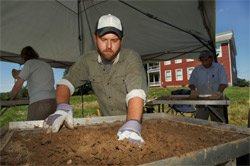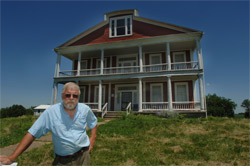
Digging up the backyard -- An archaeological team of Southern Illinois University Carbondale students, headed up by Mark Wagner of SIUC’s Center for Archaeological Investigations, is exploring the rarely photographed backyard of the Crenshaw House in Gallatin County. (Photos by Jeffrey Garner) Download Photo Here
July 01, 2011
Archaeologists taking a different look at landmark
CARBONDALE, Ill. -- A team of archaeologists under the direction of Mark Wagner, from the Center for Archaeological Investigations at Southern Illinois University Carbondale, is looking at a Southern Illinois landmark from a different perspective.
Specifically, the team is exploring the backyard of the Crenshaw House, near Equality in Gallatin County, for the Illinois Historic Preservation Agency (IHPA). The structure, known locally as “the Old Slave House,” is a state-owned historic site at the center of dozens of sensational stories, some of them true, many of them probably not. Though the archaeological team isn’t out to bust myths -- their main goal is to investigate the almost never-photographed yard surrounding the house -- their quest to find out what was really there in John Crenshaw’s day may alter some popular beliefs
Media Advisory
Members of the media may gain access to the Crenshaw House grounds, though the house is not open at all, and the grounds themselves not open to the public in general. To obtain permission to see the team in action, contact Mark Wagner at the Center for Archaeological Investigations at SIUC at mjwagner@siu.edu or at 618/453-5031.
Wagner explained that the State of Illinois owns two acres of the original 10,000 that were part of the Crenshaw properties. Those two acres include the house itself and the yard. The project laid out for Wagner and his team is to find out what was in the yard. Old photographs, even Crenshaw-era photographs, of the house exist, but almost exclusively feature the front of the house.
“What we are doing for the state is finding out what really was in the yard surrounding the house,” Wagner said. “If the state opens this as an interpretive site at some point in the future, they’ll need to know what the yard looked like, including where they could build or lay electric or sewer lines. This will enable the state to develop the site without damaging or destroying things like the remains of cellars, privies, the smokehouses once used by the Crenshaw family that may be located beneath the ground in the house yard.”
The team has a three-year grant from the Illinois Historic Preservation Agency to undertake this exploration. This does not mean the house and site are definitely going to become an open interpretative site, but certainly the exploration will contribute to an understanding of the house’s owner and how he fit into -- or didn’t -- his times.
The house, a three-story Greek revival mansion, was surmounted by a railed widow’s walk from which Crenshaw (1797-1871) could look down the valley to the Saline River to monitor his salt wells. Salt, Wagner explained, was a hot commodity in the 1800s, and Crenshaw was a magnate. His house was built to impress, and it is likely the back of the house was as impressive as the front.
Wagner’s team began its exploration with the aid of remote sensing, including use of ground-penetrating radar, electrical resistance meters and a magnetometer. The magnetometer wasn’t as effective as hoped because of the amount of iron implements discarded in the grounds, but the remote sensing did point the team to areas where excavation was likely to yield results.
Wagner noted that the two outbuildings currently on the property are not original to the Crenshaw era. Both were later additions when the house was open as a tourist site. However, the team found a cellar and the family privy, lined in stone, that date to the Crenshaw era.
“He probably had a formal layout to his yard,” Wagner said, noting that the stone-lined privy is indicative of a relatively fancy bathroom, for its day. The fact that Crenshaw would spend so much money and take such pains with a privy indicates that he was highly conscious of social standing and wanted to present himself as a prosperous landowner, Wagner said.
There is another side to the Crenshaw House, though, and the man who built it, one that is embedded (and perhaps exaggerated) in local memory and legend. Crenshaw allegedly engaged in illegal activities relating to freed slaves and indentured servants, and almost certainly his business dealings regarding indentured servants were suspect. He was twice indicted for kidnapping, though never convicted, and is said to have been a member of the “Reverse Underground Railroad,” which can mean several things. He might have kidnapped freed black slaves, he might have sold contracts for indentured servants out-of-state, he might have used his position as a resident in a “free” state but just 12 miles from a neutral state (Kentucky) to traffic illegally in interstate slave commerce.
“By all accounts, he was a hard man,” Wagner said. “This is not to whitewash him or excuse what he did, but he was not the only person in Southern Illinois or Kentucky engaged in these activities. What is remarkable in this case is that we still have a structure -- his house -- relating to the activities.”
The archaeological team is not investigating the inside of the house, though they have seen the notorious third floor attic, where Crenshaw is said to have secretly housed his victims. However, the excavation immediately behind the house revealed the foundation of a porch once attached to the back of the house and possibly dating to the early 1800s. Local legend indicates Crenshaw reportedly used a carriageway once located in this same area in the back of the house to sneak his victims inside. The discovery of the porch calls into question the truthfulness of this story about how Crenshaw might have gotten his victims inside secretly, and also whether he actually hid any kidnap victims in his house.
“Stories about Crenshaw and this house are really embedded in local memory,” Wagner said. “When the house was a tourist site, everyone in the area came here as a school kid. We’re trying to provide a better picture of what actually happened on the property.”
The team will create a full report at the conclusion of the excavation, which is set to end on Aug. 1. The site is not open to the public.

Porch excavation -- Eraina Nassa, an SIUC
alumnus from New York City, is part of the
archaeological team excavating at the
Crenshaw House in Gallatin County. She is
working on the foundation of an original back
porch, which seems to have been attached
to the house during John Crenshaw's time.
The team also found the remains of a
semi-circular cinder drive in the back of the
house.
Download Photo Here

Sifting for artifacts -- Ryan Campbell, crew
chief, an SIUC alumnus from Murphysboro,
sifts through excavated dirt in search of
John Crenshaw-era artifacts, particularly
those that might shed light on the lives of
blacks who lived on the property. Crenshaw
owned contracts for indentured servants,
and may have been involved in what was
known as the 'Reverse Underground Railroad,'
a network of lanowners and other who
kidnapped free blacks or indentured servants
and sold them or their contracts
to slave states during the Civil War years.
Download Photo Here

Crenshaw House -- Mark Wagner, an archaeologist
with the Center for Archaeological Investigations at
Southern Illinois University Carbondale, with the
Crenshaw House in the background. Wagner heads
up an archaeological team excavating the backyard
of the Crenshaw House for the Illinois Historic
Preservation Agency. The site is also known as the
Hickory Hill Historic Site, and locally as The Old
Slave House.
Download Photo Here
